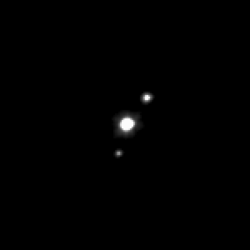 1999 OY3 among other Haumea family objects | |
| Discovery | |
|---|---|
| Discovery date | 18 July 1999 |
| Designations | |
| (86047) 1999 OY3 | |
| none | |
| Cubewano (MPC) [1] Extended (DES) [2] | |
| Orbital characteristics [3] | |
| Epoch 13 January 2016 (JD 2457400.5) | |
| Uncertainty parameter 3 | |
| Observation arc | 2572 days (7.04 yr) |
| Aphelion | 51.168 AU (7.6546 Tm) |
| Perihelion | 36.247 AU (5.4225 Tm) |
| 43.708 AU (6.5386 Tm) | |
| Eccentricity | 0.17069 |
| 288.96 yr (105544 d) | |
| 62.419° | |
| 0° 0m 12.279s / day | |
| Inclination | 24.261° |
| 301.85° | |
| 303.74° | |
| Earth MOID | 35.2941 AU (5.27992 Tm) |
| Jupiter MOID | 31.2837 AU (4.67997 Tm) |
| Physical characteristics | |
| Dimensions | 73 km [4] [5] |
| 0.7 (assumed) | |
| B-V=0.75, V-R=0.26 [6] B-V=0.71; V-R=0.37 [7] | |
| 6.8 [3] | |
(86047) 1999 OY3 (provisional designation 1999 OY3) is a trans-Neptunian object that resides in the Kuiper belt beyond Pluto. It was discovered on 18 July 1999, at the Mauna Kea Observatory, Hawaii, United States.
1999 OY3 is a candidate member of the Haumea family and, as a result, may have a high albedo. [8] Of the currently known Haumea family members, 1999 OY3 has the dimmest absolute magnitude (H) of the group at 6.8, suggesting that it is also the smallest member of the group.
